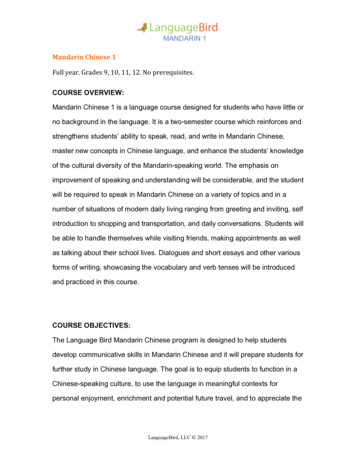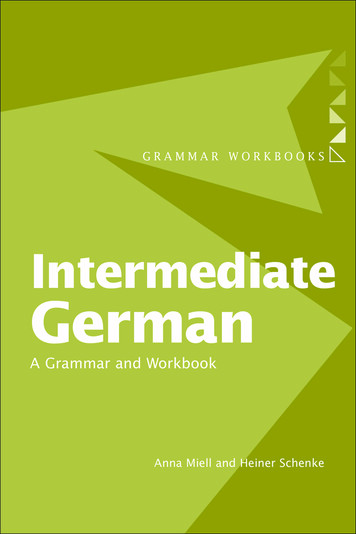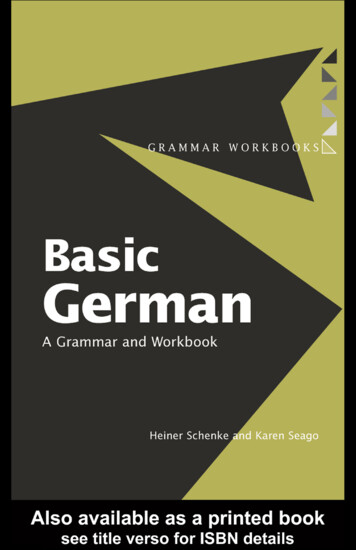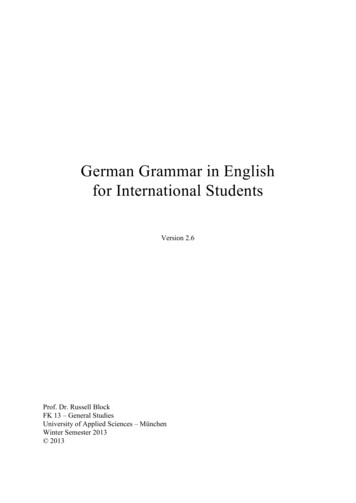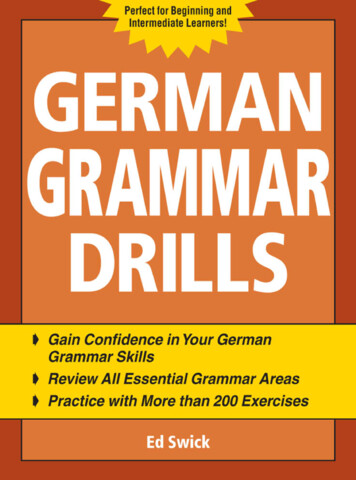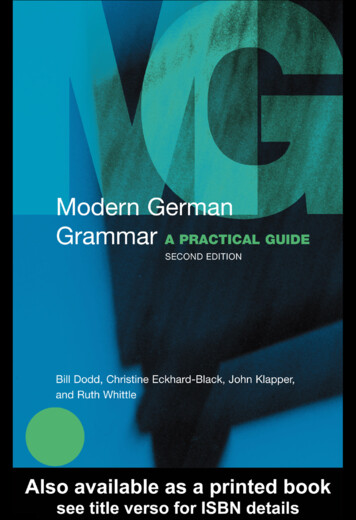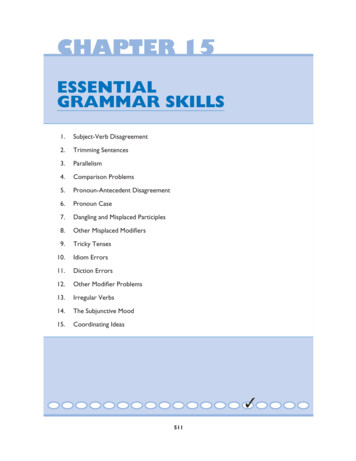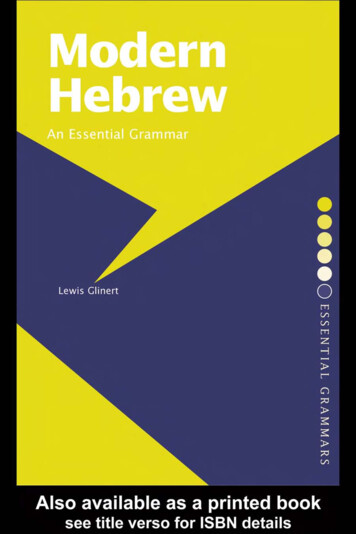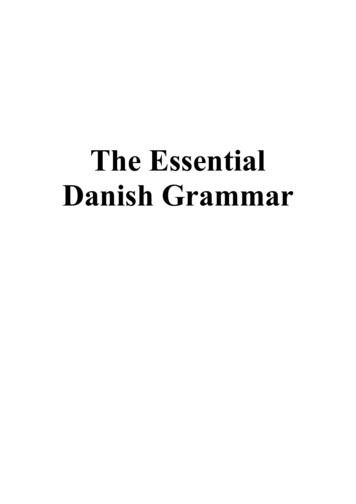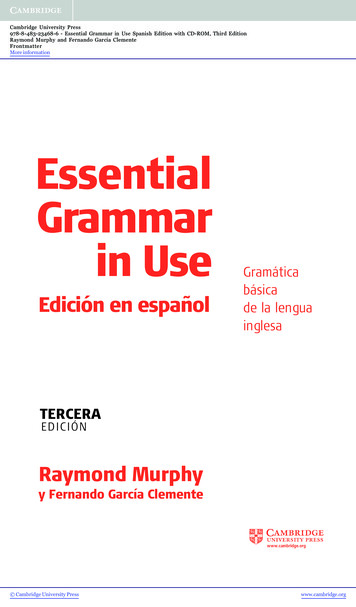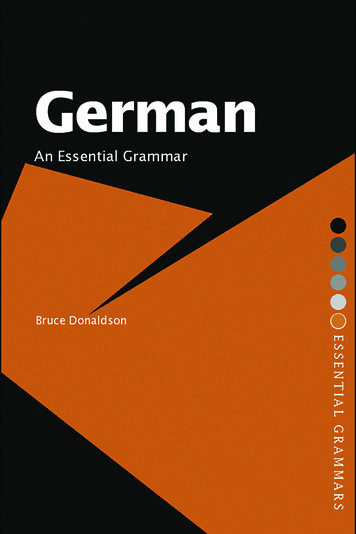
Transcription
GermanAn Essential GrammarGerman: An Essential Grammar is a practical reference guide to thecore structures and features of modern German. Presenting a fresh andaccessible description of the language, this engaging grammar uses clear,jargon-free explanations and sets out the complexities of German in short,readable sections.Suitable for either independent study or students in schools, colleges,universities and adult education classes, key features include: focus on the morphology and syntax of the languageclear explanations of grammatical termsfull use of authentic examplesdetailed contents list and index for easy access to information.With an emphasis on the German native speakers use today, German: AnEssential Grammar will help students to read, speak and write the languagewith greater confidence.Bruce Donaldson is Principal Fellow in the Department of German,Russian and Swedish Studies in the School of Languages and Linguisticsat the University of Melbourne. He has been a prolific author of languagelearning and teaching materials, including the following publications:Mastering German Vocabulary (2004), Colloquial Afrikaans (2000),Dutch: A Comprehensive Grammar (1997), Colloquial Dutch (1996) andColloquial Dutch 2 (2005).
Routledge Essential GrammarsEssential Grammars are available for the following languages:ChineseDanishDutchEnglishFinnishModern GreekModern dishThaiUrduOther titles of related interest published by Routledge:Basic German: A Grammar and WorkbookBy Heiner Schenke and Karen SeagoModern German Grammar: A Practical Guide, Second EditionBy William Dodd
GermanAn Essential GrammarBruce Donaldson
First published 2007by Routledge2 Park Square, Milton Park, Abingdon, Oxon OX14 4RNSimultaneously published in the USA and Canadaby Routledge270 Madison Ave, New York, NY 10016Routledge is an imprint of the Taylor & Francis Group, an informa businessThis edition published in the Taylor & Francis e-Library, 2006.“To purchase your own copy of this or any of Taylor & Francis or Routledge’scollection of thousands of eBooks please go to www.eBookstore.tandf.co.uk.” 2007 Bruce DonaldsonAll rights reserved. No part of this book may be reprinted or reproducedor utilised in any form or by any electronic, mechanical, or other means,now known or hereafter invented, including photocopying and recording,or in any information storage or retrieval system, without permission inwriting from the publishers.British Library Cataloguing in Publication DataA catalogue record for this book is available from the British LibraryLibrary of Congress Cataloging-in-Publication DataDonaldson, B. C. (Bruce C.), 1948–German : an essential grammar / by Bruce Donaldson.p. cm. -- (Routledge essential grammars)Includes bibliographical references and index.1. German language – Grammar. 2. German language – Textbooks forforeign speakers – English. I. Title. II. Series: Essential grammar.PF3112. D66 2006438.2 421--dc222006012912ISBN 0-203-01858-3 Master e-book ISBNISBN10: 0–415–36603–8 (hbk)ISBN10: 0–415–36602–X (pbk)ISBN10: 0–203–01858–3 (ebk)ISBN13: 978–0–415–36603–8 (hbk)ISBN13: 978–0–415–36602–1 (pbk)ISBN13: 978–0–203–01858–3 (ebk)
ContentsIntroductionAbbreviationsChapter 1 antsStressRegional variantsChapter 2 Spelling2.12.22.32.42.52.6Indicating vowel lengthUse of the UmlautUse of capital lettersUse of the hyphenThe new spellingThe alphabetChapter 3 Punctuation3.13.23.33.4CommasColons with direct speechInverted commas/quotation marksExclamation marksChapter 4 Case4.14.24.34.4Case endings on nounsOther uses of the nominative caseOther uses of the accusative caseThe genitive casexixv1133789991010111213131515161718202021v
Contents4.54.64.7Other uses of the dative caseNouns in appositionOrder of cases in paradigms222324Chapter 5 Articles and other determiners255.15.25.35.45.5The definite articleOther determiners inflected like der/die/dasThe indefinite articleOther determiners inflected like einIndefinite pronouns used as determinersChapter 6 Nouns6.16.26.36.46.56.66.76.86.9Gender of nounsPluralization of nounsDiminutization of nounsNames of townsNames of countriesFeminizing agentsAdjectival nounsCompound nounsNouns in apposition (see 4.6)Chapter 7 Pronouns7.17.27.37.47.57.67.7Personal pronounsPossessivesReflexive pronounsDemonstrative pronounsInterrogative pronounsRelative pronounsIndefinite pronounsChapter 8 Adjectives8.1vi8.28.38.4Rules for inflection8.1.1 The der/die/das (weak) endings8.1.2 The ein/eine/ein (mixed) endings8.1.3 The unpreceded adjectival (strong) endings8.1.4 Adjectival endings after indefinite pronouns8.1.5 Indeclinable adjectivesComparative of adjectives and adverbsSuperlative of adjectives and adverbsPredicate adjectives followed by a prepositional 6975767676777878798183
Chapter 9 Adverbs9.19.29.39.49.59.69.7Adverbs that are also adjectivesComparative and superlative of adverbsIntensifying adverbsAdverbs of timeAdverbs of place and directionAdverbs of manner and degreeInterrogative adverbsChapter 10 Verbs10.110.210.310.410.510.610.710.8Formation of tenses10.1.1 The present tense10.1.2 The future tense10.1.3 The imperative10.1.4 The imperfect tense10.1.5 The perfect tense10.1.6 The pluperfect tense10.1.7 The future perfect tense10.1.8 The conditional tense10.1.9 The conditional perfect tenseModal auxiliary verbs10.2.1 Double infinitive constructions10.2.2 Modals used with perfective infinitivesThe subjunctive10.3.1 The subjunctive I10.3.2 The subjunctive IIThe passiveThe infinitive10.5.1 Characteristics of the infinitive10.5.2 Rules for the use of zu with infinitives10.5.3 Use of um . . . zu before infinitives10.5.4 Double infinitive constructions (see 10.2.1)10.5.5 The infinitive used as a nounParticiples10.6.1 Present participles10.6.2 Past participles10.6.3 Use of present and past participles in extendedadjectival phrases (see 7.6.4)Progressive tensesReflexive 4154154154155155156157vii
Contents10.9Verbal prefixes10.9.1 Verbs with separable prefixes (separable verbs)10.9.2 Verbs with inseparable prefixes (inseparableverbs)10.9.3 Verbs with variable prefixes (separable orinseparable verbs)10.10 Verbs followed by prepositional objects10.10.1 Use of prepositional adverbs beforesubordinate clauses10.11 Transitive and intransitive verbs10.11.1 Use of sein and lassen with intransitive verbs10.11.2 Intransitive verbs and the passive10.12 List of irregular verbs10.12.1 Alphabetical list of irregular verbsChapter 11 Conjunctions11.111.211.311.4Coordinating conjunctionsSubordinating conjunctionsConjunctions introducing infinitive clausesCorrelative conjunctionsChapter 12 Prepositions12.112.212.312.412.512.6Prepositions that take the accusative casePrepositions that take the dative casePrepositions that take both the accusative and thedative casePrepositions that take the genitive caseContraction of prepositions with the definite articleHow to translate ‘to’ into GermanChapter 13 rdinal numeralsOrdinal ling the 222223223225226
13.10 Measurement13.11 School marks/gradesChapter 14 Negation14.114.2Position of nicht (not) and nie(mals) (never)Notes on negatives227228Contents230230232Chapter 15 Common German abbreviations237Appendix 1: List of countries, inhabitants andadjectives/languages238Index252ix
IntroductionThere are numerous German grammars on the market, so why this one?This book has been written specifically with the needs of the intermediatelearner at secondary or particularly tertiary level in mind. It is intendedto be used as a reference grammar, which does not mean that it is utterlycomprehensive, but it does cover everything that might be called ‘essential’knowledge for someone who has reached the intermediate level.So what constitutes the intermediate level? That depends of course, but itwould certainly apply to anyone who has completed an elementary coursein German at a university, i.e. people who are in their second or third yearof tertiary German, having started it at university without having done it atschool. Students at advanced secondary level, however, would also qualifyas intermediate and will thus find this book pitched at their needs, as willthose teaching themselves who are progressing beyond what one might callbeginners’ level. Once you have mastered the contents of this book, youwill have reached a point in your learning of German where you are ableto express yourself at quite a sophisticated level. Needless to say, you willalso need to be concentrating on building up your vocabulary – grammaris useless on its own.Other than being a book pitched squarely at the needs of the intermediatelearner, what does this book offer its readers that other similar books maynot? It has been written by someone with nearly forty years of experiencein teaching German and Dutch at tertiary level, specializing in teachingstudents in their second year of German at university. The author is alltoo well aware of the shortcomings of the many textbooks available forthe learning of German – take for example the way in which nearly allsuch books tackle German plurals. They nearly all fail to help the learnersee through to the underlying system and thus fail to illustrate that pluralformation is not nearly as arbitrary as it often appears to be to the newcomerto the language. How many books, for example, in their first introductionxi
Introductionto plural formation, mention that Mann has a plural in Männer, but failto mention that there are only about ten masculine nouns in the entirelanguage that have a plural in er, which is otherwise an ending limitedto neuter nouns? How many grammars tell you, to take another example,that possibly no more than 10 per cent of German nouns are neuter? So, ifforced to guess a gender, it would be safer to assume the noun is masculineor feminine before assuming it is neuter. These two examples are typical ofmany of the underlying truths about German grammar that one discoversonly through learning and teaching the language. These are also thingswhich seldom strike the native speaker and why, at certain levels of learninga language, one may be better off with non-native teachers – they havebeen through the mill, as it were, which natives by definition have not. Thisbook contains numerous such insights into German, acquired over manyyears of involvement with the language, both as a student and as a teacher.The author has applied his insights and long experience in explaining theintricacies of German to English-speaking people in as simple a fashion asthe often complex material permits. German is certainly not simple – butthen no language is – but it can be explained in a simpler, more palatablefashion than many books do.Learning German is a challenge, but the rewards are great. No languageother than English is of more use to you when travelling aroundEurope. Not only are there many more Germans (82 million) thanthere are French, Italians or Spaniards, for example, but the countriesof Austria, Switzerland and Luxembourg further swell those numbersby several million native-speakers, not to mention the German-speakingminorities living in Russia, Romania, Hungary, Italy, Belgium andDenmark. All in all, the number of native-speakers of German livingin Europe is nigh on 100 million. But go travelling through easternEurope and you will be amazed at how well Poles, Hungarians andeven Latvians, for example, can speak German too; their German isoften much better than their English. Germany is an economic powerof enormous importance and lies both physically and philosophicallyat the heart of the European Union. If you are interested in Europe andseek to broaden your linguistic and cultural horizons, you need look nofurther than German.xiiOther books you might refer to may use different names for several of thegrammatical concepts dealt with in this book. Particularly in the Americanand British English-speaking worlds different terminology is often usedfor various concepts. For this reason, where alternative terminology existsfor a given concept, it is briefly discussed before proceeding with the issue
under consideration and all grammatical concepts can be accessed under allalternative names via the index.IntroductionThere is an old German maxim: ohne Vergleich kein Verständnis (withoutcomparison, there is no understanding). The approach to German grammaradopted in this book is strongly contrastive with English. English andGerman are after all, as languages go, very closely related and have a greatdeal in common. Look, for example, at the past tenses of irregular verbs(trinken/trank/getrunken) and the forms and functions of modal verbs(kann/muss/will). These are grammatical complexities that clearly stemfrom a common source, namely the Anglo-Saxon invasion of Britain in thefifth century ad. And then there is all that common vocabulary dating fromthe same time, e.g. Mutter, Vater, Sohn, Tochter, Hund, Katze, Schwein etc.All that the two languages have in common is a godsend to the learner,but then there is so much that the two do not (or no longer, as is often thecase) have in common and this is where taking a contrastive approach canbe invaluable. However, in order to do so, you need to be aware of exactlywhat the grammatical situation is in English with regard to a given issue.There are issues of which a native-speaker is often unaware. This is all themore so these days, when English at school level throughout the Englishspeaking world seldom includes analysis of formal grammar the way itused to. Generally speaking, this now mean
Basic German: A Grammar and Workbook By Heiner Schenke and Karen Seago Modern German Grammar: A Practical Guide, Second Edition By William Dodd. German An Essential Grammar Bruce Donaldson. First published 2007 by Routledge 2 Park Square, Milton Park, Abingdon, Oxon OX14 4RN Simultaneously published in the USA and Canada by Routledge 270 Madison Ave, New York, NY
